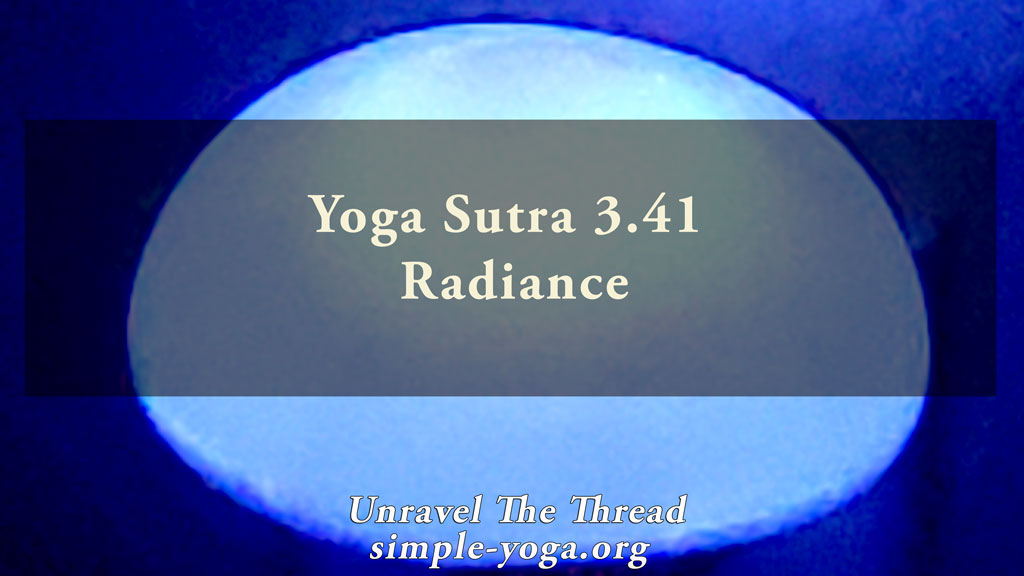
3.39 Entering somebody else’s body
January 24, 2022
3.41 Radiance
February 6, 2022
3.39 Entering somebody else’s body
January 24, 2022
3.41 Radiance
February 6, 20223.40 Lightness and levitation

3.40 Mastery over the udana vayu enables lightness, levitation and leaving the body at will.
Yoga studies life in all its aspects. The fourth limb of yoga, pranayama, presented in sutra 2.49, consists of developing an intimate knowledge of the flow of prana, the primordial force animating sensations and actions in all living beings. Their study of the life force led ancient yogis to classify the flow of prana into five major winds or vital airs (vayu). These five types of life energy are known as prana, apana, samana, vyana and udana. The first one, confusingly enough also named prana, is thought to be responsible for processes of bringing vitality into the body. Some sources suggest that prana is related to inhalation, whereas other sources maintain that prana is responsible for both inhalation and exhalation. This first form of prana is thought to sustain the organs of perception and to reside in the upper portion of the body, including the heart.
Apana animates the processes of elimination. Some authors associate apana with exhalation and with the lower section of the torso. Samana is connected to digestion and assimilation. Samana is thought to operate in the abdominal region. Vyana is the vital force pervading the whole body, including the limbs. Therefore, vyana sustains the organs of movement.
Udana is the ascending vital force, responsible for burping, speech, and elevated states of consciousness. Udana is in charge of sustaining the tissues of the body. This udana aspect of the life force is also thought to leave the body at will at the moment of death. Remember how in Chapter One of the Yoga Sutra aphorism 1.39 suggests directing your single-pointed focus to anything uplifting. In Chapter Two, sutras 2.33 and 2.34 encouraged the cultivation of uplifting thoughts and emotions (pratipaksha bhavana). This aphorism 3.40 says that meditative integration on the ascending life force, udana, will enable the practitioner to avoid sinking in water, mud, or stepping into thorns. Additionally, learning to regulate udana ensures ascending out of the body through the crown of the head at the time of death, which is believed to be the safe passage to escape the endless cycle of birth, death, and rebirth.
Is it possible to notice how the feeling of lightness operates in your being?
What thoughts and actions contribute to feeling light and buoyant?
Where do the sensations of lightness arise?
How do they travel?
Which of your choices and decisions support feeling light?
When you go to sleep, does focusing on the feeling of lightness influence the quality of your rest?
What happens if you choose to focus on lightness when you first notice that you are awake?
Does that choice influence your thoughts, attitude, actions, and interactions during your day?
As usual, one more way of exploring the meaning of this sutra is by chanting it.
You can choose to chant it in its traditional form with some of the words coming together:
3.40 udānajayāat jalapaṅkhakaṇṭakādiṣvasaṅgo’tkrāntiśca
उदानजयात् जलपङ्ककण्टकादिष्वसङ्गोऽत्क्रान्तिश्च ॥४०॥
Another option is to chant each word in the sutra individually:
- udāna
- jayāt
- jala
- paṅka
- kaṇṭaka
- ādiṣu
- asaṅgaḥ
- utkrāntiḥ
- ca
If you prefer, you may listen to the podcast:
This is an excerpt from the book Unravel the thread: Applying the ancient wisdom of yoga to live a happy life
If you find Simple-Yoga.org and Unravel the thread useful, consider supporting my labor with a donation, you may also donate using PayPal or Venmo. Thank you!
